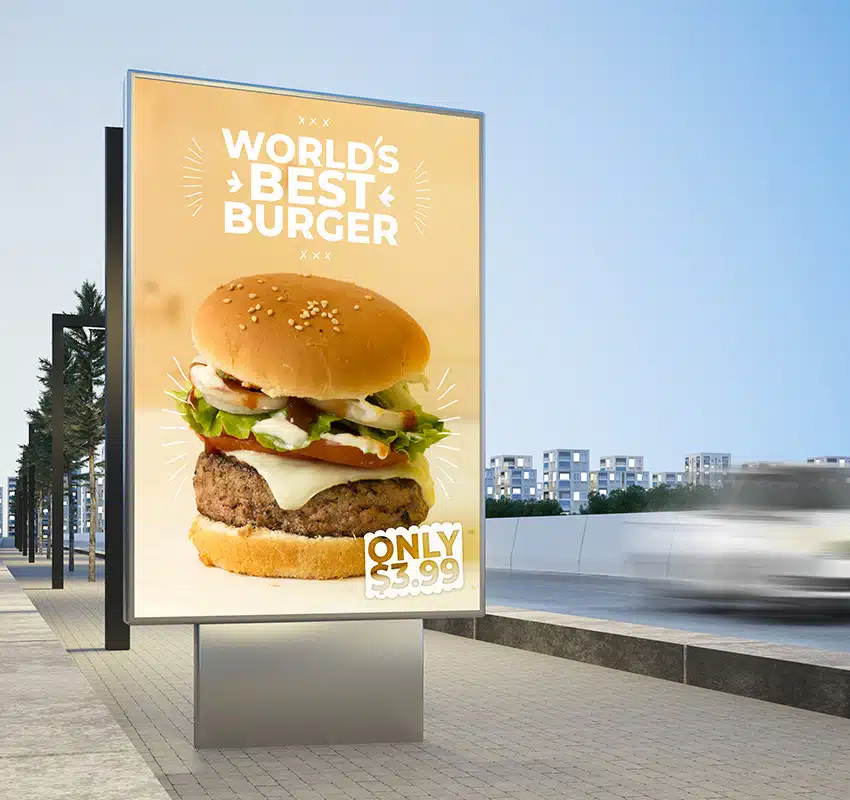What is Programmatic OOH?
Programmatic Out-of-Home (OOH) refers to the automated buying and selling of Digital Out-of-Home (DOOH) advertising spaces using data-driven technology. Unlike traditional OOH, which requires manual negotiations, programmatic OOH utilizes software to optimize ad placements efficiently and target specific audiences based on data. This article explores the benefits, workings, and types of programmatic OOH, providing a clear understanding for advertisers looking to enhance their strategies.
Key Takeaways
- Programmatic OOH automates the buying and selling of digital out-of-home ads, leveraging data and machine learning for more efficient and precise targeting.
- By integrating Demand-Side Platforms (DSPs), Supply-Side Platforms (SSPs), and ad exchanges, Programmatic OOH streamlines the ad-buying process, reducing manual efforts and middlemen.
- Programmatic OOH offers enhanced targeting capabilities, flexibility for real-time adjustments, and reliable metrics for measuring campaign effectiveness, making it a potent tool for advertisers.
What is Programmatic DOOH?
Programmatic ad buying within the DOOH sector brings significant improvements over traditional OOH methods by:
- Automation: The process automates transactions for acquiring DOOH ads, eliminating the need to engage directly with media owners.
- Efficiency: Harnessing both automation and insightful data enables programmatic digital OOH to streamline and optimize ad placements for increased relevance and impact on target audiences.
- Targeting Precision: Advertisers using programmatic out-of-home methods can achieve better targeting by using specific parameters such as location, time, or audience profile.
Advanced data-driven tools empower businesses to make informed decisions, integrating machine learning with complex strategies to enhance planning, scheduling, and monitoring of online advertising. Programmatic DOOH enables precise targeting of demographic groups, ensuring more effective consumer outreach.
Understanding Programmatic OOH
Programmatic Digital Out-of-Home (DOOH) leverages advanced technologies like artificial intelligence and automated computing to streamline the entire advertising process on digital displays. This includes planning, purchasing, targeting, selling, delivering, and analyzing ads with greater efficiency. By automating these processes, programmatic OOH eliminates the need for manual negotiations, making transactions between advertisers and media owners more seamless and efficient.
Programmatic OOH uses data-driven insights to precisely target specific audience groups, significantly enhancing the precision and relevance of ad placements. This approach represents a major advancement in ad targeting and performance measurement, as it allows for the use of detailed audience data and tailored segmentations to optimize campaign outcomes. Ads are delivered to the right audience at the right time, maximizing the impact and effectiveness of each campaign.
How Programmatic OOH Works
Programmatic OOH has revolutionized the purchasing of advertising space by integrating Demand-Side Platforms (DSPs), Supply-Side Platforms (SSPs), and ad exchanges. This integration allows for automated, rapid acquisition of outdoor advertising spaces via real-time bidding, streamlining a previously lengthy process. By reducing intermediaries, programmatic technology enables digital buyers to easily incorporate DOOH into broader strategies, promoting efficient purchasing.
One of the most impressive benefits of Programmatic OOH is its precision in targeting audiences. Advertisers can utilize mobile location data to identify where their target demographic congregates and serve ads to them throughout their day. Real-Time Bidding (RTB) plays a crucial role, enabling on-the-spot decision-making for accurate ad distribution across multiple publishers’ platforms, while continuously measuring performance using various metrics.
Demand-Side Platforms (DSPs)
DSPs significantly streamline the media purchasing process for advertisers by offering broad inventory access, data-driven targeting, real-time bidding, and capabilities to deliver, monitor, and refine ads. Advertisers can set specific criteria, such as audience demographics, budget constraints, and campaign timelines, simplifying campaign management.
This automation, driven by programmatic technology, makes Programmatic OOH more accessible, fostering dynamic Digital OOH and adaptable HTML5 content formats, and enabling purchases across multiple platforms simultaneously.
Supply-Side Platforms (SSPs)
Media owners use SSPs to automate the trading of ad space with various demand sources. An SSP connects a media owner’s inventory to multiple DSPs, ensuring effective use of ad space and securing top prices. This automation boosts efficiency and profitability by simplifying transactions involving DOOH inventory.
The use of SSPs in Programmatic DOOH advertising enhances campaign effectiveness by accessing new markets and attracting additional potential buyers.
Ad Exchanges
Ad exchanges act as intermediaries between Demand-Side Platforms (DSPs) and Supply-Side Platforms (SSPs). They:
- Streamline the automation of purchasing and selling ad space.
- Facilitate the seamless distribution of creative content for advertisements.
- Enhance the overall process of securing ad placements.
- Bridge connections between marketers and media space owners.
- Enable real-time delivery of ads.
- Improve the distribution of programmatic Out-of-Home (OOH) advertising.
This programmatic process boosts both efficiency and effectiveness in Programmatic OOH campaigns, ensuring that ads reach the right audience at the right time.
Types of Programmatic OOH Ads
Programmatic Out-Of-Home (OOH) advertising encompasses various formats, each designed to engage audiences in different environments and moments.
Digital Billboards
Digital billboards are high-definition displays strategically placed in high-traffic areas like city centers and highways. These dynamic platforms can be instantly updated to deliver timely and engaging content, maximizing impact. They represent a significant portion of advertising investments, accounting for 38% of spending.
Place-Based Media
Place-based media includes screens strategically positioned in locations like malls, airports, stadiums, and office buildings. These screens allow advertisers to tailor messages based on the specific environment, time of day, and audience demographics, effectively communicating with the intended audience in their immediate surroundings.
Point of Purchase Displays
Located near checkout counters and store shelves, point-of-purchase displays influence consumers’ buying decisions at the moment of sale. These screens are effective for:
- Promoting special deals or coupons to encourage immediate purchases.
- Capturing shoppers’ attention when they are about to make a transaction.
- Enhancing the impact of programmatic OOH advertising campaigns.
Benefits of Programmatic OOH
Programmatic Out-of-Home (OOH) advertising offers a range of advantages, making it a powerful tool for advertisers. Key benefits include:
Enhanced Targeting Capabilities
Utilizing data-driven targeting, Programmatic OOH offers advertisers the capability to:
- Access accurate datasets for specific audiences and tailor audience segments accordingly.
- Utilize both first-party and third-party data sources.
- Formulate targeted audiences by observing their behaviors as well as the places they frequent.
The efficacy of location-based targeting is bolstered through the application of geofencing techniques and mobile location analytics, which guarantees that ads are displayed to an optimally relevant audience precisely when it’s most effective.
Flexibility and Real-Time Adjustments
Programmatic OOH grants advertisers the capability to execute multiple creatives and messages within a single campaign, refining these in real-time for optimal performance. The flexibility of dynamic creative optimization tailors ads to align with changing external conditions like weather or specific audience demographics, thus amplifying the effectiveness of the advertising initiative.
The use of real-time analytics facilitates ongoing surveillance and refinement of campaigns, guaranteeing their continued pertinence and ability to captivate the intended audience.
Efficient Ad Buying Process
Programmatic buying within programmatic Out-of-Home (OOH) advertising optimizes the process of purchasing ads by eliminating numerous manual tasks. Demand-side platforms (DSPs) facilitate a more efficient and accurate mechanism for advertisers and media agencies to acquire Digital Out-of-Home (DOOH) media.
The integration with top-tier DSPs enhances the capability for dynamic DOOH, as well as adaptive HTML5 formats. This enables effortless ad placements throughout various publisher platforms while effectively overseeing DOOH ad inventory.
Improved Measurement and ROI
Programmatic Out-of-Home (OOH) offers dependable metrics and assessment studies that are comparable to other digital channels, which enables advertisers to accurately gauge the effectiveness of their campaigns. Critical indicators like Cost-per-Mille (CPM) and Return on Ad Spend (ROAS) aid advertisers in comprehending the financial efficiency and influence of their ad campaigns.
Advertisers can refine their strategies for improved return on investment by utilizing a range of data sources along with attribution analysis through Programmatic OOH. This allows for strategic optimization within advertising campaigns.
Measuring the Success of Programmatic OOH Campaigns
Evaluating the success of Programmatic DOOH campaigns is essential for optimizing strategies. Key performance metrics include brand awareness, recall, and direct attribution. Financial indicators like Cost Per Lead (CPL) and Return on Ad Spend (ROAS) are critical for assessing efficiency and financial outcomes.
Additional metrics include Exposed Visitation Rate (EVR), which tracks consumer actions following ad exposure, and incremental sales lift, which compares sales data in areas exposed to DOOH ads against those that aren’t. Web and app analytics, along with surveys, provide deeper insights into brand perception and purchase motivation after ad exposure.
Key Performance Indicators (KPIs)
Setting clear objectives and identifying KPIs is crucial for measuring the performance of Programmatic DOOH campaigns. Metrics such as reach, engagement, and conversions provide empirical evidence of campaign success, allowing advertisers to make informed, data-driven decisions.
Data Collection Methods
Advertisers use various techniques to collect data and gauge the effectiveness of Programmatic OOH campaigns, including:
- Geofencing
- Wi-Fi sensors
- Surveys
- QR codes
- Sales comparisons
- Mobile positioning data
These methods help track consumer behavior, conversion rates, and unique reach, providing valuable insights into audience engagement.
Future Trends in Programmatic OOH
The future of Programmatic OOH is being shaped by emerging trends and technological advancements. The integration of AI, machine learning, and mobile advertising is expected to enhance targeting accuracy and campaign effectiveness. Advances in digital signage technology, driven by 5G, will enable dynamic and responsive ad formats, offering advertisers greater opportunities for engagement.
Integration with Mobile Advertising
The combination of Programmatic OOH and mobile advertising enables cohesive cross-channel campaigns that deliver a consistent brand narrative across various touchpoints, amplifying consumer engagement and campaign results.
Advances in Data Analytics
Utilizing sophisticated data analytics within Programmatic OOH will yield:
- Enhanced segmentation of the audience for precision targeting
- Detailed understanding of consumer behaviors and inclinations
- Access to real-time insights enabling more precise ad delivery
- Ads that are both pertinent and captivating to the audience
Employing these enhanced analytic capabilities allows advertisers to refine their campaigns, ensuring maximum effectiveness.
The improvements in data analysis technologies empower advertisers with advanced strategic tools, enhancing the efficacy of Programmatic OOH as a method for engaging with consumers in meaningful ways.
Expansion of Digital Signage
The advancement in digital signage technology is anticipated to propel forward-looking developments in programmatic Out-of-Home (OOH) advertising, introducing a greater variety of engaging and responsive ad formats. The integration of 5G technology is poised to be a critical factor, allowing for faster data transfer speeds and the ability to refresh ads instantaneously.
As a result of these technological advancements, advertisers should be better equipped to create outdoor advertising campaigns that not only draw attention but also deeply connect with their target audience, increasing the effectiveness and success rate of their OOH efforts.
Getting Started with Programmatic OOH
Starting a Programmatic OOH campaign requires careful planning. Begin by setting clear objectives, such as increasing brand visibility or driving in-store visits, and select ad placements that align with these goals.
Partner with reputable DSPs and SSPs to access premium Programmatic OOH inventory and collaborate with experienced media strategists to optimize campaign performance.
Choosing the Right Platforms
Selecting the right platforms is crucial for a successful campaign. Evaluate DSPs based on your advertising goals, target audience, budget, and platform features. This ensures that you choose the best platform for your needs, increasing the likelihood of success.
Setting Clear Objectives
It is critical to set definitive goals for your Programmatic OOH campaign as they guide the formulation of your strategy and the method by which you’ll assess results. Goals might include raising brand awareness, promoting a product, or increasing store visits. These will shape your overall approach and aid in choosing suitable ad placements and creative designs.
These established aims offer a structure to gauge the success of your campaign and facilitate decisions grounded on data to enhance its effectiveness.
Partnering with Experts
Collaborating with experienced media strategists and media owners enhances the effectiveness of your ad campaign within the programmatic DOOH space. Their expertise in this field can help you achieve better outcomes, optimize targeting, and improve engagement with your audience.
Summary
Programmatic advertising DOOH is revolutionizing outdoor advertising by merging automation with data-driven insights to refine ad placements on digital signage within public venues. This approach enhances targeting precision, allows real-time modifications, streamlines the ad purchasing process, and improves measurement and return on investment (ROI). By leveraging technological platforms like DSPs, SSPs, and ad exchanges, advertisers can create more compelling campaigns.
With ongoing advancements in Programmatic OOH, including the integration of mobile advertising and enhancements in data analytics and digital screen technology, the potential for impactful audience engagement continues to grow. Embrace this next-gen approach to connect with your target demographic more effectively than ever.











